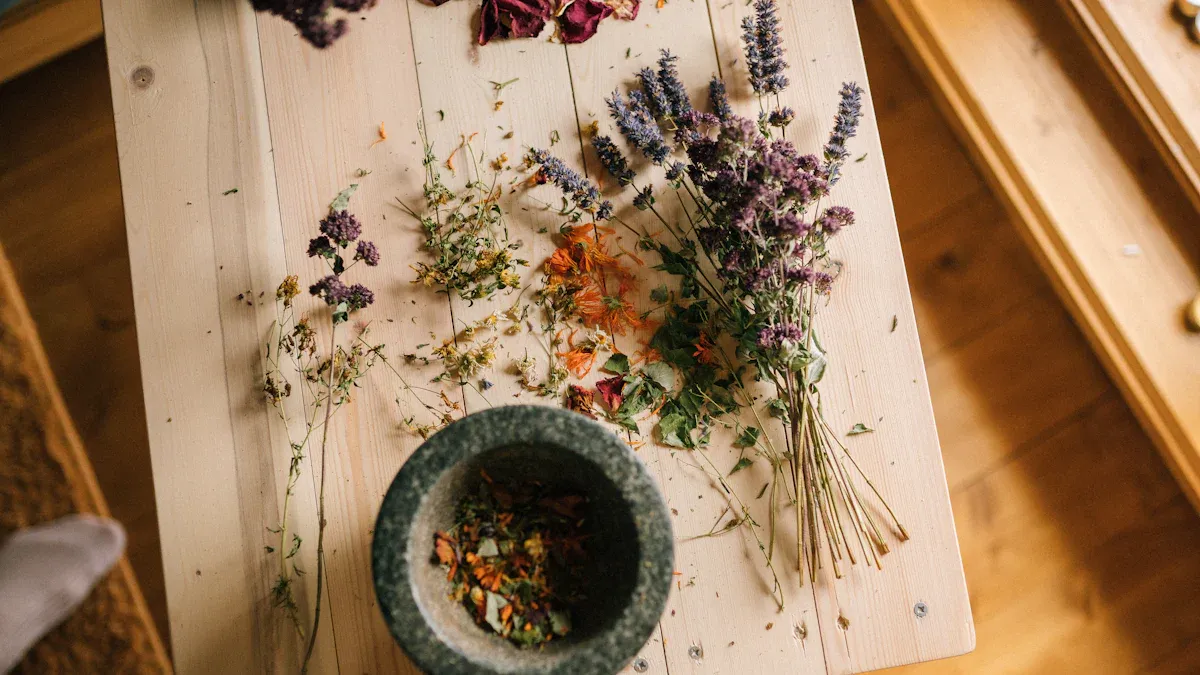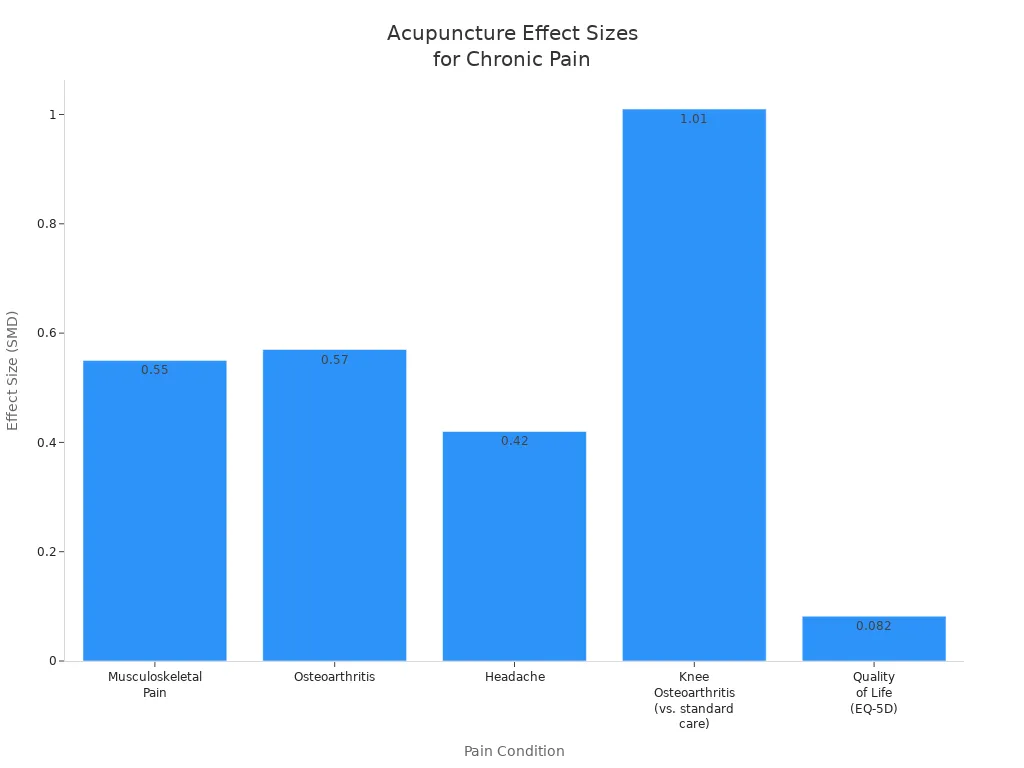What Alternative Therapies Really Help with Common Health Issues

You probably know someone who has tried meditation, herbal teas, or acupuncture to feel better. In fact, almost 75% of adults in the U.S. have used some form of complementary or alternative medicine (CAM) at least once. Take a look at how common this is:
Description | Percentage |
|---|---|
Adults who have ever used CAM (including prayer) | 75% |
Adults who have used CAM in the past 12 months | 62% |
Not all therapies work the same. Some, like acupuncture for pain or relaxation techniques for sleep and anxiety, have real science behind them. Others need more research. You want to feel better, but safety always comes first. That means talking to your healthcare provider before trying something new. Exploring Alternative Therapies: What Works and What Doesn’t can help you sort out what’s helpful and what’s just hype.
Key Takeaways
Acupuncture, yoga, and mindfulness therapies have strong scientific support for managing pain, anxiety, and sleep issues.
Always consult your healthcare provider before trying new therapies to ensure safety and avoid harmful interactions.
Tai Chi is effective for improving balance and reducing fall risk, especially in older adults.
Not all alternative therapies are effective; homeopathy and unregulated herbal supplements lack strong evidence.
Integrating alternative therapies with standard care can enhance your overall health and well-being.
What Are Alternative Therapies?

You might hear people talk about alternative therapies when they want to try something different from regular medical care. These therapies include things like acupuncture, herbal medicine, yoga, and meditation. You may see them used alone or with standard treatments. Let’s break down what makes them unique.
CAM vs. Conventional Medicine
When you look at health care, you’ll notice two main paths. Conventional medicine is what you find in most hospitals and clinics. Doctors use scientific research to diagnose and treat illnesses. You get medicines, surgery, or psychotherapy. This approach aims to prevent and treat diseases.
Complementary and alternative medicine (CAM) works a bit differently. CAM includes therapies developed outside of mainstream Western medicine. You might use acupuncture, herbal remedies, or yoga alongside your regular treatment. These methods focus on your whole body and mind, not just symptoms. CAM often tries to help you feel better and improve your quality of life.
Here’s a quick look at how major health organizations describe these approaches:
The National Center for Complementary and Integrative Health says alternative therapies are health care approaches developed outside of mainstream Western or conventional medicine.
Conventional medicine relies on scientific research for diagnosis and treatment, using things like medications and surgery.
Complementary medicine is used with conventional treatments and focuses on holistic approaches.
Why People Choose Alternatives
You may wonder why so many people turn to alternative therapies. Some want to avoid side effects from regular medicine. Others look for ways to manage stress, pain, or chronic conditions. You might feel curious about natural remedies or want more control over your health.
Many people like that CAM treats the whole person, not just the illness. You may find comfort in practices that help you relax or feel more balanced. Exploring Alternative Therapies: What Works and What Doesn’t can help you decide which options fit your needs and lifestyle.
Tip: Always talk to your doctor before starting any new therapy. Your safety comes first!
Exploring Alternative Therapies: What Works and What Doesn’t

You might feel overwhelmed by all the choices out there. Exploring Alternative Therapies: What Works and What Doesn’t can help you sort through the most popular options. Let’s look at which therapies have strong scientific support, which ones need more research, and which are best for common health problems.
Therapies with Strong Evidence
Some alternative therapies stand out because scientists have studied them carefully. You can feel more confident trying these options, especially if you want help with pain, balance, sleep, or anxiety.
Acupuncture
Acupuncture uses tiny needles to target specific points on your body. Many people try it for pain relief. Large studies show acupuncture helps with chronic pain, including musculoskeletal pain, osteoarthritis, and headaches. The effects last for months, and the benefits go beyond just placebo.
Here’s a quick look at how acupuncture works for different pain conditions:Pain Condition
Effect Size (SMD)
95% Confidence Interval (CI)
Musculoskeletal Pain
0.55
0.51 to 0.58
Osteoarthritis
0.57
0.50 to 0.64
Headache
0.42
0.37 to 0.46
Knee Osteoarthritis (vs. standard care)
1.01
0.61 to 1.43
Quality of Life (EQ-5D)
0.082
0.047 to 0.116

You might notice that acupuncture helps not only with pain but also with your overall quality of life. Researchers say the effects last at least a year after treatment.
Tai Chi
Tai Chi is a gentle exercise that helps you move slowly and focus on your balance. If you worry about falling or want to improve your physical function, Tai Chi is a great choice. Studies show older adults who practice Tai Chi improve their balance and reduce their fear of falling.
Here’s what some studies found:Study
Outcome Measure
Result
Audette et al., 2006
One leg standing
Significant improvements compared to control
Gatts & Woollacott, 2006
Timed Up & Go test
Significant reductions in time for TC
Li et al., 2005b
One leg standing
Significant improvements compared to control
Stenlund et al., 2005
Climbing boxes
Significant improvements with TC and QG
Song et al., 2003
Trunk flexion
Significant improvements with TC
You can use Tai Chi to boost your balance and feel steadier on your feet.
Mindfulness-Based Therapies
Mindfulness teaches you to pay attention to the present moment. If you struggle with insomnia, mindfulness-based cognitive therapy can help you sleep better. Studies show that practicing mindfulness reduces how long you stay awake at night and helps you feel less anxious before bed.
People who use mindfulness techniques report better sleep quality and less worry about falling asleep.Yoga and Relaxation Training
Yoga combines movement, breathing, and relaxation. You can use yoga to help with anxiety, sleep, and even chronic pain. Relaxation training, like progressive muscle relaxation or meditation, also helps lower anxiety.
Meta-analyses show yoga and relaxation training work well for panic disorder and general anxiety.Aromatherapy
Aromatherapy uses essential oils like lavender or citrus to help you relax. You might use it to lower stress or anxiety before a medical procedure. Studies show that inhaling these oils can calm your mind and improve sleep quality.
Here’s a quick look at how aromatherapy works:Study Focus
Essential Oils Used
Findings
Stress Relief
Lavender, Bergamot, Orange
Over 70% of trials showed positive effects on anxiety levels
Sleep Quality
Various Oils
Improved sleep by reducing stress, anxiety, and depression
Pre-Procedure Anxiety
Lavender, Citrus, Rose
Significant reduction in anxiety for patients awaiting procedures
Tip: If you want to try one of these therapies, ask your doctor or a qualified practitioner for advice.
Therapies with Limited Support
Not every alternative therapy has strong scientific backing. Some options sound promising but need more research before you can trust them.
Homeopathy
Homeopathy uses tiny amounts of natural substances to treat symptoms. Major health organizations agree that homeopathy does not work better than a placebo for any health condition.The National Health and Medical Research Council found no reliable evidence for homeopathy.
The European Academies Science Advisory Council said homeopathy’s claims are implausible.
Experts believe any benefits are likely due to the placebo effect.
Herbal Supplements
You might see herbal supplements advertised for anxiety or depression. The results are mixed. Studies show big differences in how these supplements are made and tested. Many studies are sponsored by manufacturers, which can affect the results.
Here are some common problems with herbal supplement studies:Limitation
Description
Variability among studies
Significant differences in study designs and populations, leading to inconsistent results.
Publication bias
Many studies were sponsored by manufacturers, potentially skewing results in favor of their products.
Lack of standardized agents
Different herbal products were used without standardization, complicating comparisons.
Insufficient evidence
Current studies do not provide conclusive data showing that herbal supplements are superior to pharmaceuticals.
Early-phase studies
Most studies were not advanced enough (no phase III trials), limiting the reliability of findings.
Measurement inconsistencies
Different scales were used to assess symptoms, affecting the comparability of results.
You should use caution with herbal supplements and always talk to your doctor first.
Emotional Freedom Technique (EFT)
EFT combines tapping on your body with talking about your feelings. Some people say it helps with stress or anxiety, but there isn’t enough strong evidence yet. You might want to try other therapies with more research behind them.
Best Options for Common Issues
You want to know which therapies work best for your needs. Exploring Alternative Therapies: What Works and What Doesn’t can guide you to the safest and most effective choices.
Chronic Pain
Acupuncture, yoga, and massage therapy show moderate benefits for chronic pain, especially low back pain. Tai Chi helps older adults manage pain and improve movement.Therapy
Evidence Summary
Acupuncture & Dry Needling
Chiropractic Care
Significant improvements for acute low-back pain within 6 weeks.
Massage Therapy
Short-term improvements in pain and function.
Yoga, Tai Chi, & Mindfulness
Reductions in pain medication needs after a 12-week yoga program.
Anxiety
You can use relaxation training, yoga, and mindfulness-based therapies to lower anxiety. Aromatherapy also helps, especially before stressful events.Therapy Type
Effectiveness Description
Relaxation Training
Significant efficacy in reducing anxiety; applied relaxation, progressive relaxation, and meditation showed greater effect sizes.
Exercise
Modestly beneficial for anxiety disorders; positive effects noted in systematic reviews and meta-analyses.
Yoga
Positive effects particularly for panic disorder; considered a therapeutic option for anxiety.
Mindfulness-based Interventions
Effective as adjunctive treatment for anxiety disorders, with positive effects persisting through follow-up.
Insomnia and Sleep Problems
Mindfulness-based therapies, yoga, Tai Chi, and acupressure help improve sleep quality. Aromatherapy can also help you relax and fall asleep faster.Therapy
Evidence Level
Notes
Tai Chi
Positive
Suggested improvement in sleep quality, especially among older adults.
Yoga
Positive
Shown to reduce sleep latency and improve total sleep in older participants.
Acupuncture
Mixed
Inconsistent efficacy; some studies show improvement in sleep quality scores.
Acupressure
Positive
Evidence supports its use in improving sleep quality.
Herbal Medicine
Insufficient
Valerian shows mixed results; further research needed.
Bright Light Therapy
Positive
Beneficial for restoring circadian rhythm and improving early-morning awakenings.
Balance and Fall Prevention
Tai Chi is your best bet for improving balance and lowering your risk of falls. Older adults see big improvements in physical function and confidence.
Exploring Alternative Therapies: What Works and What Doesn’t gives you the tools to make smart choices. You can use therapies with strong evidence to manage pain, anxiety, sleep, and balance. Always check with your healthcare provider before starting something new.
Safety and Choosing Practitioners
Evaluating Safety
You want to feel better, but you also want to stay safe. Some alternative therapies, like herbal supplements and acupuncture, can cause side effects or interact with your regular medicine. Herbal remedies have many different chemicals, and it’s hard to know which ones work or which ones might cause problems. If you take other medications, herbs can change how they work or even make them less effective. Sometimes, using alternative therapies can delay getting the right diagnosis or treatment. Always tell your doctor about any therapies you try, even if you feel unsure. Your doctor needs to know everything you use to help keep you safe.
Finding Qualified Providers
Choosing the right practitioner makes a big difference. In the United States, rules for alternative therapy providers change from state to state. Some states have strict laws, while others do not. You should look for providers with proper credentials and training. Here’s a table to help you spot trusted certifications:
Credential/Certification | Institution |
|---|---|
Institute for Functional Medicine | |
American Academy of Anti-Aging Medicine | |
American Board of Integrative Medicine | |
American Board of Family Medicine | |
Fellowship in Anti-Aging and Regenerative Medicine | |
American Academy of Nurse Practitioners | |
American Board of Obesity Medicine |
Tip: Ask about your provider’s training and check their certifications before you start any therapy.
Supplement Use Tips
Herbal and dietary supplements can help, but they also carry risks. People with chronic illnesses, those taking many medications, and anyone with organ problems need to be extra careful. Some supplements, like vitamin K, can change how blood thinners work. Others, like ginseng or chamomile, can lower the effect of certain medicines. Always follow these steps:
Talk with your doctor before taking any supplement.
Share all supplements you use with your healthcare provider.
Write down your symptoms and stop using a supplement if you do not feel better.
Avoid taking more than the recommended dose.
Report any new or worsening symptoms to your doctor.
Follow label instructions. Pregnant or breastfeeding people, those under 18 or over 65, and anyone having surgery should always check with a healthcare provider first.
Integrating Therapies with Standard Care
Talking to Your Doctor
You might feel nervous about bringing up alternative therapies with your doctor. Many people worry their doctor will not listen or might tell them to stop. Sometimes, doctors do not ask about these therapies unless you mention them. Take a look at some common barriers:
Barrier Type | Description |
|---|---|
Patient-related | You may not share your use of alternative therapies because you fear a negative reaction or disinterest. |
Physician-related | Doctors might not see alternative therapies as part of their job and may not start the conversation. |
You can make these talks easier by building trust and sharing your health goals. Try to discuss your use of alternative therapies openly. Your doctor wants to help you make safe choices. Good communication means you and your doctor talk about your whole health—mind, body, and spirit. You should feel comfortable sharing your concerns and asking questions. If you feel unsure, bring a support person to your appointment.
Tip: Write down any supplements or therapies you use and bring the list to your doctor. This helps your healthcare team keep you safe.
Practical Integration Steps
You want to get the most out of both standard care and alternative therapies. Here are some steps to help you blend them safely:
Look for reliable information from unbiased sources before trying a new therapy.
Talk with your healthcare team about the risks and benefits of each therapy.
Keep a complete list of all supplements and share it with your doctor.
Never give supplements to children without checking with their healthcare team.
Use care coordination to make sure all your providers share information and work together.
Integrative medicine can support your body’s natural healing, lower stress, and help you make healthy lifestyle changes. These therapies should not replace regular medical care. You need to coordinate with your primary care provider to avoid confusion.
Care coordination helps everyone stay on the same page. Here are some resources that can help:
Resource | Description |
|---|---|
Care Coordination | Organizes care and shares information among all providers for safer treatment. |
Care Coordination Quality Measure (CCQM-PC) | Assesses care coordination experiences in primary care. |
Care Coordination Measures Atlas | Offers frameworks for measuring and improving care coordination. |
Exploring Alternative Therapies: What Works and What Doesn’t shows you how to combine therapies for better health. When you talk openly and use these steps, you can make informed choices and feel confident about your care.
You have many alternative therapies to choose from, but some stand out for safety and effectiveness. These include:
Yoga for balance
Meditation for stress
Chiropractic care for back pain
Ginger tea for digestion
Before you try anything new, talk with your healthcare provider. This helps you avoid harmful interactions and keeps you safe. For reliable information, check trusted sources like the Natural Medicines Comprehensive Database or the National Center for Complementary and Alternative Medicine. Take time to weigh your options, ask questions, and make choices that fit your needs.
FAQ
Can you use alternative therapies with your regular medicine?
Yes, you can often use them together. Always talk to your doctor first. Some therapies or supplements can interact with your medicine or affect your treatment plan.
How do you know if an alternative therapy is safe?
Check if research supports the therapy. Look for licensed or certified practitioners. Ask your doctor for advice. If you feel unsure, start slow and watch for side effects.
Will your insurance cover alternative therapies?
Some insurance plans cover therapies like acupuncture or chiropractic care. Coverage depends on your provider and state. Call your insurance company to ask what they include.
What is the best way to start with alternative therapies?
Tip: Start with one therapy at a time. Keep track of how you feel. Share your experience with your healthcare provider. This helps you find what works best for you.
Which alternative therapies should you avoid?
Homeopathy (no strong evidence)
Unregulated herbal supplements
Therapies that promise quick cures
Stick with options backed by research and always check with your doctor.
See Also
Exploring Symptoms And Treatment Options For Choroid Plexus Carcinoma
Symptoms And Treatment Approaches For Adrenocortical Adenoma
Recognizing Symptoms And Treatment Strategies For Conjunctival Melanoma
Identifying Symptoms And Treatment Methods For Duodenal Cancer
Essential Symptoms, Diagnosis, And Treatment Insights For LGL Leukemia
